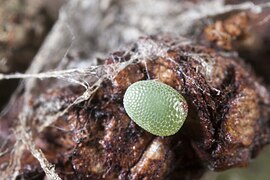Milionia basalis
| Milionia basalis | ||||||||||||
|---|---|---|---|---|---|---|---|---|---|---|---|---|

Milionia basalis |
||||||||||||
| Systematics | ||||||||||||
|
||||||||||||
| Scientific name | ||||||||||||
| Milionia basalis | ||||||||||||
| Walker , 1854 |
Milionia basalis is a butterfly ( moth )found in Asiafromthe Spanner family (Geometridae).
features
butterfly
The moths reach a wingspan of 50 to 56 millimeters. There is no difference in color between the sexes. The basic color of the wings is black. On the upper side of the forewing, the discal region clearly stands out golden yellow, orange or red-orange. The basal shimmers depending on the light sometimes radiating metallic blue. The submarginal region on the upper side of the hind wing is also colored golden yellow, orange or red-orange and crossed by a series of black, oval spots. The thorax and abdomen are covered in silky black hair and sometimes have a metallic bluish shimmer.
egg
The egg has an oval shape, is slightly flattened at the base and shows a slightly raised, net-like shell structure. Freshly laid eggs have a greenish color that turn red shortly before the caterpillars hatch.
Caterpillar
The caterpillars are black in color and are covered over the entire surface of the body with a dense, white, grid-like pattern and some thin gray hairs. The black spiracles stand out from the orange side stripe. The head capsule, the anal segment and the feet are also orange in color.
distribution and habitat
Milionia basalis occurs in the northeastern Himalayan foreland, in Indonesia , Malaysia , Myanmar , Thailand , Vietnam , in southeast China as well as in Japan and Taiwan . The main habitat are mountainous coniferous forests. The species was detected at altitudes of over 1600 meters. In addition to the nominate form Milionia basalis basalis , the following subspecies are known:
- Milionia basalis guentheri Butler , 1881 (Sumatra)
- Milionia basalis pyrozonis Butler , 1882 (Malaysia, Myanmar)
- Milionia basalis sharpei Butler , 1886 (Borneo)
Way of life
The moths are mostly diurnal, but also appear at night in artificial light sources . The caterpillars feed on the needles of resin discs ( Dacrydium ) or stone discs ( Podocarpus ). They also absorb toxins with their food and are thus avoided by predators. In China, the large-leaved stone yew ( Podocarpus macrophyllus ) was identified as a food plant. Phylogenetic examinations were also carried out there and mitochondrial DNA was created. On Sumatra , the caterpillars prefer the Merkus pine ( Pinus merkusii ), on which they appear very harmful every year.
Synonyms
- Milionia zonea Moore , 1872
- Milionia latifasciata Butler , 1881
- Milionia butleri Druce , 1882
- Milionia pryeri Druce , 1888
- Milionia ochracea Thierry-Mieg , 1907
Individual evidence
- ↑ Milionia basalis in Japan
- ↑ a b The Moths of Borneo
- ↑ Yimin Du, Xiang Song & Zhanjun Lu: Phylogenetic relationship and characterization of the complete mitochondrial genome of Milionia basalis (Lepidoptera: Geometridae) , Mitochondrial DNA Part B Resources, Vol. 4, No. 2, Taylor & Francis Group, 2019, pp. 4136-4137
- ^ KSS Nair (Editor): Insect Pests and Diseases in Indonesian Forests , Center for International Forestry Research Bogos, Indonesia, 2000, ISBN 979-8764-52-8 , p. 34
literature
- KSS Nair (Editor): Insect Pests and Diseases in Indonesian Forests , Center for International Forestry Research Bogos, Indonesia, 2000, ISBN 979-8764-52-8
Web links
- Lepiforum e. V. - Taxonomy and photos
- biodiv.tw - Milionia basalis in Taiwan




